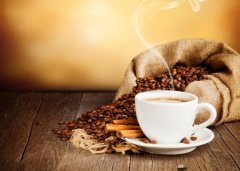Authentic Vietnamese coffee boutique coffee common sense
I watched a documentary about Vietnamese cuisine in National Geographic, and there was a lot of talk about Vietnamese coffee. I have always thought that the coffee beans sold in Vietnam are very bad, with uneven roasting and different particle sizes, which looks like the waste beans from our roasted coffee. Look at the coffee used in the store interviewed in the film, and that's exactly what it is. But Vietnamese people's habit of drinking coffee is very common. Moreover, the way of brewing is highly unified, that is, the Vietnamese pot named after their country.

In fact, it is super simple to make coffee from a Vietnamese pot. It is even rougher to look at coffee shops in Vietnam. They will not make a cup for you like this. The container they use to filter coffee is about five or six times the size of your pressure cooker, constantly filtering it there, and it all looks like it is overextracted to me. If guests want iced coffee in summer, just take a glass, scoop some ice cubes, add a lot of condensed milk, and then scoop some coffee from their oversized coffee containers and stir it. It's super fast, but don't tell me, it looks tempting.
The inspiration from watching the film is that they add so much condensed milk! So I also gave myself a hard measure this time, adding the height of the cup to 1x5. Sure enough, condensed milk increases the consistency of the coffee and tastes smooth. The coffee is strong enough, so even with a lot of ice, it doesn't feel light, and ah, it's really dripping coffee, stirring it, it's a cup of iced coffee!
Vietnamese coffee has its own style. Coffee beans are deeply roasted and extracted into coffee by drip filtration. It's called a dripping pot in Vietnam.
Vietnamese coffee with condensed milk, this is unique, if added with ice, it will become iced coffee.
Now let's talk about the specific use of dripping pots in Vietnam:
1. Preparation items: Vietnamese Didi pot condensed milk Vietnamese local coffee beans coffee spoon

2. Untie the Didi kettle and take out the pressure plate to prepare.

3. Pour an appropriate amount of condensed milk into the coffee cup.

4. Add your own coffee powder, it is best to be more detailed.

5. Dig two spoons with a coffee spoon (estimated to be about 15g)

6. Shake the coffee powder flat, install a pressure plate, and then tighten it.

7. Put the drip pot on the cup and pour some water, which refers to the standard of soaking coffee powder but not dripping water. This step is also used in follicular coffee, the technical term "steaming", after 20 seconds or so put about 90 degrees of water, full.

8. Then leave it for about 3 minutes.

It's three minutes. It's finished.

Important Notice :
前街咖啡 FrontStreet Coffee has moved to new addredd:
FrontStreet Coffee Address: 315,Donghua East Road,GuangZhou
Tel:020 38364473
- Prev

Queen Bee Coffee Special Italian Coffee Making Steps
Strong alcohol coffee vanilla, vaguely filled with brandy aroma, smell relaxed, sip when you can enjoy the sweet taste of honey, unforgettable! Features: Made of high-grade brandy, the smell is more mellow. Tip: coffee, honey, brandy in the order poured. Flavor: Aromatic Ingredients: 1 cup hot coffee, 1/2 OZ honey, 2~3 drops Brandy, fresh milk
- Next

The whole process of making coffee flowers
The whole process of master flower drawing: simple props, understated movements, the whole performance process is really amazing.
Related
- Beginners will see the "Coffee pull flower" guide!
- What is the difference between ice blog purified milk and ordinary milk coffee?
- Why is the Philippines the largest producer of crops in Liberia?
- For coffee extraction, should the fine powder be retained?
- How does extracted espresso fill pressed powder? How much strength does it take to press the powder?
- How to make jasmine cold extract coffee? Is the jasmine + latte good?
- Will this little toy really make the coffee taste better? How does Lily Drip affect coffee extraction?
- Will the action of slapping the filter cup also affect coffee extraction?
- What's the difference between powder-to-water ratio and powder-to-liquid ratio?
- What is the Ethiopian local species? What does it have to do with Heirloom native species?

